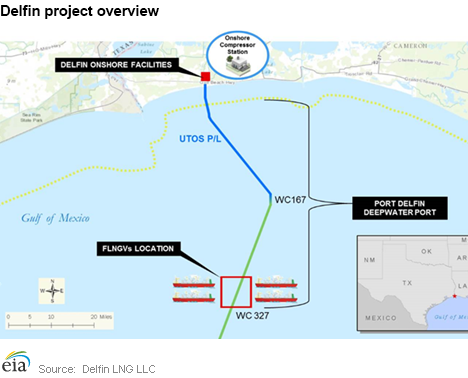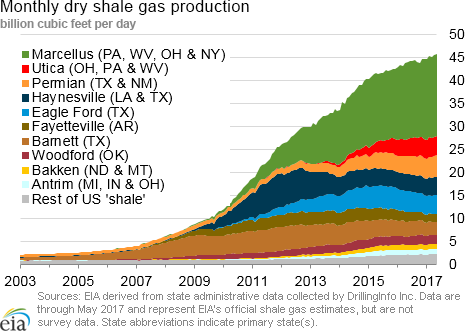In the News:
First U.S. floating LNG export facility receives approval to export to non-FTA countries
On June 1, the Delfin LNG, LLC floating liquefaction project received approval from the U.S. Department of Energy (DOE) for long-term liquefied natural gas (LNG) exports of up to 1.8 billion cubic feet per day (Bcf/d) to countries that do not have free trade agreements with the United States (non-FTA countries). Delfin, located off the coast of Louisiana, is the first floating liquefaction facility in U.S. waters to receive such authorization. In 2014, it received authorization from DOE to export the same amount of LNG to FTA countries.
The Delfin project includes onshore facilities in Cameron Parish, Louisiana (including a compressor station), pipelines to move natural gas offshore approximately 40 miles to an offshore port with up to four moorings, and four floating liquefaction vessels. The currently idled U-T Offshore Systems pipeline, which Delfin purchased from Enbridge, Inc. in 2014, and the High Island Offshore Pipeline, which was abandoned and transferred to Delfin, will transport natural gas from onshore to the offshore moorings. In contrast, the recently-launched PFLNG Satu project in Malaysia (the first operational floating liquefaction facility worldwide) includes offshore production facilities that will be directly tapped for feedgas.
Unlike LNG terminals located onshore or in state waters, where the Federal Energy Regulatory Commission (FERC) is the lead agency to perform the National Environmental Policy Act (NEPA) review, facilities like Delfin, which is located in federal waters, are reviewed under NEPA by the Maritime Administration of the Department of Transportation (MARAD). In addition, for terminals located in deep water, the U.S. Coast Guard (USCG) and governors of adjacent coastal states must also give approval.
Delfin received a positive Record of Decision from MARAD and the USCG on March 13. Because onshore facilities are included in the project, Delfin is also seeking FERC approval. If Delfin receives approval and reaches a final investment decision, it currently expects to be operational in 2021 or 2022. However, no LNG export project beyond those currently under construction has reached a final investment decision.
With this ruling, DOE has approved LNG exports of 21 Bcf/d to non-FTA countries. LNG export projects already in operation or under construction and expected to enter service before 2020 have the capacity to export 9.4 Bcf/d. For comparison, the 2016 global trade in LNG totaled 34.7 Bcf/d according to the International Group of Liquefied Natural Gas Importers.
Overview:
(For the Week Ending Wednesday, June 14, 2017)
- Natural gas spot prices fell at most locations this report week (Wednesday, June 7 to Wednesday, June 14). The Henry Hub spot price fell from $2.99 per million British thermal units (MMBtu) last Wednesday to $2.90/MMBtu yesterday.
- At the New York Mercantile Exchange (Nymex), the July 2017 contract price fell 9¢ from $3.020/MMBtu last Wednesday to $2.933/MMBtu yesterday.
- Net injections to working gas totaled 78 Bcf for the week ending June 9. Working natural gas stocks are 2,709 Bcf, which is 11% less than the year-ago level and 9% more than the five-year (2012–16) average for this week.
- The natural gas plant liquids composite price at Mont Belvieu, Texas, fell by 8¢, averaging $5.74/MMBtu for the week ending June 14. The price of natural gasoline, propane, butane, and isobutane fell by 4%, 3%, 1%, and 1%, respectively. The price of ethane rose by 4%.
- According to Baker Hughes, for the week ending Friday, June 9, the natural gas rig count increased by 3 to 185. The number of oil-directed rigs rose by 8 to 741. The total rig count increased by 11, and it now stands at 927.
Prices/Supply/Demand:
Prices fall across the country. This report week (Wednesday, June 7 to Wednesday, June 14), the Henry Hub spot price fell 9¢ from $2.99/MMBtu last Wednesday to $2.90/MMBtu yesterday, with a weekly high of $3.08/MMBtu on Monday. Prices at the Chicago Citygate decreased 11¢ from $2.86/MMBtu last Wednesday to $2.75/MMBtu yesterday, also hitting a weekly high—$2.93/MMBtu—on Monday. Prices at PG&E Citygate in Northern California fell 11¢, down from $3.17/MMBtu last Wednesday to $3.06/MMBtu yesterday. The price at SoCal Citygate decreased 11¢ from $3.17/MMBtu last Wednesday to $3.06/MMBtu yesterday.
Temperatures along the East Coast and in the lower Midwest increased from below-normal temperatures last Thursday to above-normal temperatures Monday. These higher temperatures, in some regions more than 10 degrees Fahrenheit above seasonal norms, drove increased power demand and higher spot prices on Monday. However, temperature forecasts moderated the rest of the week, and most spot prices ended the period lower than last week.
Boston and New York City prices exhibit wide oscillations. Prices at Northeast points also varied with the weather. At the Algonquin Citygate, which serves Boston-area consumers, prices went down 12¢ from $2.24/MMBtu last Wednesday to $2.12/MMBtu yesterday, after going as high as $3.28/MMBtu on Monday. The Transcontinental Pipeline Zone 6 trading point for New York had similar price movements, with a net weekly decrease of 11¢, from $2.22/MMBtu last Wednesday to $2.11/MMBtu yesterday, but a weekly high of $3.09/MMBtu on Monday.
Tennessee Zone 4 Marcellus spot prices decreased 30¢ from $1.99/MMBtu last Wednesday to $1.69/MMBtu yesterday. Prices at Dominion South in northwest Pennsylvania fell 18¢ from $2.00/MMBtu last Wednesday to $1.82/MMBtu yesterday.
Nymex prices fall to three-month low. At the Nymex, the price of the July 2017 contract decreased 9¢, from $3.020/MMBtu last Wednesday to $2.933/MMBtu yesterday. This price is the lowest price for the front-month Nymex contract since mid-March. The price of the 12-month strip averaging July 2017 through June 2018 futures contracts declined 8¢ to $3.020/MMBtu.
Supply remains flat. According to data from PointLogic, the average total supply of natural gas remained the same as the previous report week, averaging 77.2 Bcf/d. Dry natural gas production remained constant week over week. Average net imports from Canada increased by 1% from last week.
Demand rises. Total U.S. consumption of natural gas rose by 3% compared with the previous report week, according to data from PointLogic. Power burn climbed by 11% week over week because of warm temperatures in the East. Industrial sector consumption decreased by 1% week over week. In the residential and commercial sectors, consumption declined by 13%. Natural gas exports to Mexico increased 13%.
Sabal Trail Pipeline to begin service. The Federal Energy Regulatory Commission issued a letter order authorizing the Sabal Trail Pipeline to begin service in some of the facilities that were built in Phase I of the construction project. The pipeline runs from a connection with the Transco Pipeline in Alabama to the Central Florida Hub. The partial service allows delivery of more than 0.4 Bcf/d of natural gas.
U.S. LNG exports increase week over week. Five vessels (combined LNG-carrying capacity of 18.2 Bcf) departed Sabine Pass last week (Thursday to Wednesday), and one vessel (LNG-carrying capacity 3.8 Bcf) was loading at the terminal on Wednesday.
Storage:
Net injections for the week were below the five-year average. Net injections into storage totaled 78 Bcf for the week ending June 9, compared with the five-year (2012–16) average net injection of 87 Bcf and last year's net injections of 68 Bcf during the same week. With the exception of last week, most of the recent storage weeks have had net injections lower than the five-year average.
Most regions had lower-than-average net injections. Net injections were lower than or equal to the five-year average in all regions except the East. Temperatures in the East were cooler than normal, resulting in reduced demand for air conditioning. Net injections in the East region totaled 34 Bcf, 6 Bcf more than the five-year average. In the Midwest, by contrast, net injections totaled 20 Bcf, 7 Bcf less than the five-year average. In total, net injections for the Lower 48 states were 9 Bcf lower than the five-year average this week.
Working gas levels are 11% lower than last year’s record levels, and 9% higher than the five-year average. Working gas stocks total 2,709 Bcf, which is 228 Bcf more than the five-year average and 322 Bcf less than last year at this time. This year-over-year deficit prevails in each of the regions of the Lower 48 states. The South Central region has the largest year-over-year deficit at 119 Bcf, although it shrank relative to last week. The East region has the largest deficit in relative terms, at 90 Bcf, 15% lower than last year’s stock level, shrinking relative to last week. In contrast, working gas levels are higher than the five-year averages in all regions except the East and the Pacific regions, which are 43 Bcf and 24 Bcf lower than their five-year averages, respectively. The South Central region accounts for 183 Bcf of the surplus compared with the five-year average, which in volumetric terms is the largest share of all of the regions.
The January futures price is trading at a premium over the current spot price, but it is smaller than a year ago. During the most recent storage week, the average natural gas spot price at the Henry Hub was $2.93/MMBtu, while the Nymex futures price of natural gas for delivery in January 2018 averaged $3.35/MMBtu, a difference of 42¢. The premium was 88¢ a year ago. In comparison, during the most recent storage week, the average natural gas spot price at the Henry Hub was $2.93/MMBtu, 8¢ lower than the front-month futures price at the Nymex. A year ago, the spot price was 13¢ lower than the front-month contract.
Reported net implied flows into storage are just below the range of market expectations for the week. According to Bloomberg’s survey of natural gas analysts, estimates of net injections to working natural gas storage ranged from 80 Bcf to 95 Bcf with a median of 89 Bcf, compared with EIA’s figure of 78 Bcf. The price of the Nymex futures contracts for July 2017 delivery at Henry Hub increased in the seconds after the release of the Weekly Natural Gas Storage Report (WGNSR), climbing to around $3.00/MMBtu, about 5¢ above the pre-release price. At the release of the WNGSR, 834 trades were executed.
Nationally, temperatures averaged near seasonal norms. Temperatures in the Lower 48 states averaged 69°F, 1°F higher than the normal and 3°F lower than last year at this time. Cooling degree days (CDD) in the Lower 48 states totaled 38, compared to 55 last year and compared to a normal of 39. Heating degree days (HDD) in the Lower 48 states totaled 12, compared with 4 last year and a normal of 17.
See also:
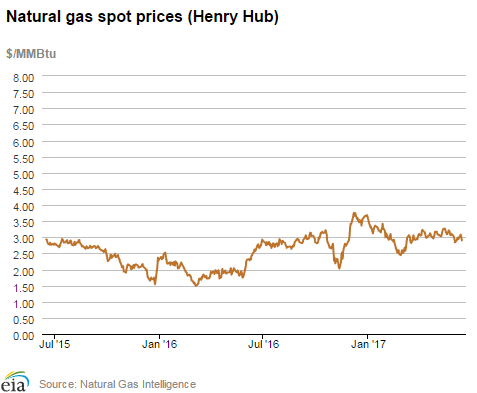
| Spot Prices ($/MMBtu) | Thu, 08-Jun |
Fri, 09-Jun |
Mon, 12-Jun |
Tue, 13-Jun |
Wed, 14-Jun |
|---|---|---|---|---|---|
| Henry Hub |
2.94 |
2.98 |
3.08 |
3.01 |
2.90 |
| New York |
2.09 |
2.71 |
3.09 |
2.19 |
2.11 |
| Chicago |
2.82 |
2.84 |
2.93 |
2.85 |
2.75 |
| Cal. Comp. Avg.* |
2.85 |
2.73 |
2.81 |
2.73 |
2.80 |
| Futures ($/MMBtu) | |||||
| July Contract | 3.028 |
3.039 |
3.024 |
2.966 |
2.933 |
| August Contract |
3.062 |
3.071 |
3.054 |
2.989 |
2.953 |
| *Avg. of NGI's reported prices for: Malin, PG&E Citygate, and Southern California Border Avg. | |||||
| Source: NGI's Daily Gas Price Index | |||||
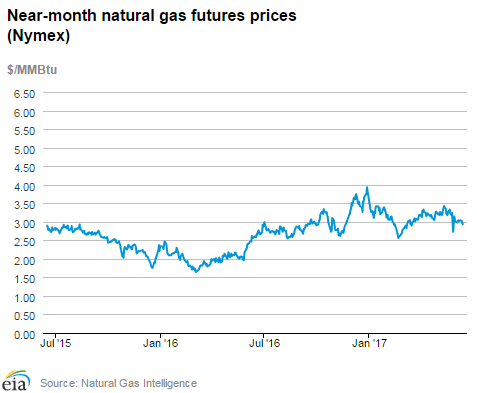
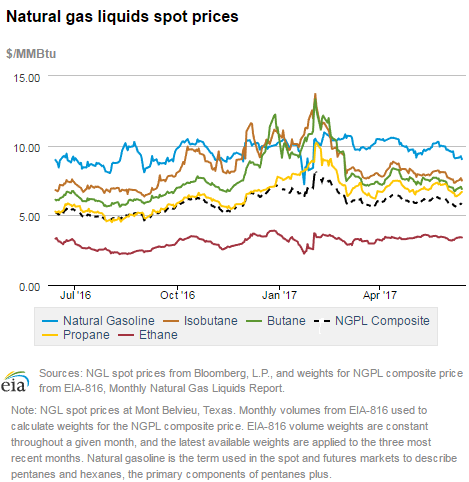
| U.S. natural gas supply - Gas Week: (6/8/17 - 6/14/17) | |||
|---|---|---|---|
Average daily values (Bcf/d): |
|||
this week |
last week |
last year |
|
| Marketed production | 80.6 |
80.9 |
80.0 |
| Dry production | 71.6 |
71.9 |
71.2 |
| Net Canada imports | 5.7 |
5.6 |
6.2 |
| LNG pipeline deliveries | 0.0 |
0.0 |
0.0 |
| Total supply | 77.2 |
77.4 |
77.4 |
|
Source: OPIS PointLogic Energy, an IHS Company | |||
| U.S. natural gas consumption - Gas Week: (6/8/17 - 6/14/17) | |||
|---|---|---|---|
Average daily values (Bcf/d): |
|||
this week |
last week |
last year |
|
| U.S. consumption | 55.8 |
54.2 |
58.5 |
| Power | 29.4 |
26.5 |
31.1 |
| Industrial | 19.6 |
19.8 |
19.5 |
| Residential/commercial | 6.8 |
7.9 |
7.9 |
| Mexico exports | 4.2 |
3.7 |
3.8 |
| Pipeline fuel use/losses | 6.2 |
6.0 |
6.5 |
| LNG pipeline receipts | 2.2 |
2.2 |
0.6 |
| Total demand | 68.4 |
66.1 |
69.4 |
|
Source: OPIS PointLogic Energy, an IHS Company | |||
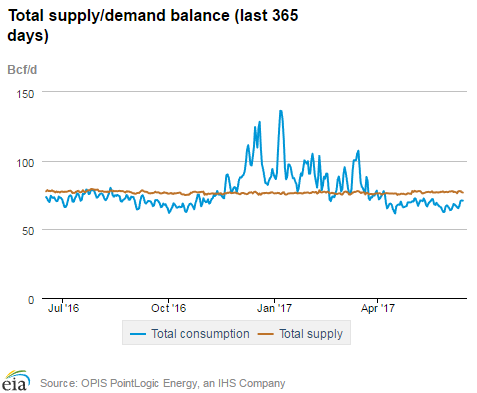
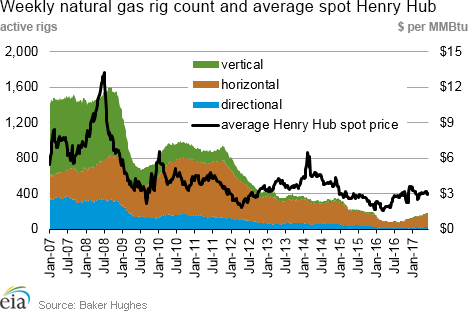
| Rigs | |||
|---|---|---|---|
Fri, June 09, 2017 |
Change from |
||
last week |
last year |
||
| Oil rigs | 741 |
1.1% |
125.9% |
| Natural gas rigs | 185 |
1.6% |
117.6% |
| Note: Excludes any miscellaneous rigs | |||
| Rig numbers by type | |||
|---|---|---|---|
Fri, June 09, 2017 |
Change from |
||
last week |
last year |
||
| Vertical | 81 |
5.2% |
76.1% |
| Horizontal | 780 |
1.2% |
141.5% |
| Directional | 66 |
-2.9% |
46.7% |
| Source: Baker Hughes Inc. | |||
| Working gas in underground storage | ||||
|---|---|---|---|---|
Stocks billion cubic feet (Bcf) |
||||
| Region | 2017-06-09 |
2017-06-02 |
change |
|
| East | 491 |
457 |
34 |
|
| Midwest | 634 |
614 |
20 |
|
| Mountain | 177 |
172 |
5 |
|
| Pacific | 274 |
269 |
5 |
|
| South Central | 1,133 |
1,119 |
14 |
|
| Total | 2,709 |
2,631 |
78 |
|
| Source: U.S. Energy Information Administration | ||||
| Working gas in underground storage | |||||
|---|---|---|---|---|---|
Historical comparisons |
|||||
Year ago (6/9/16) |
5-year average (2012-2016) |
||||
| Region | Stocks (Bcf) |
% change |
Stocks (Bcf) |
% change |
|
| East | 581 |
-15.5 |
534 |
-8.1 |
|
| Midwest | 700 |
-9.4 |
552 |
14.9 |
|
| Mountain | 187 |
-5.3 |
147 |
20.4 |
|
| Pacific | 311 |
-11.9 |
298 |
-8.1 |
|
| South Central | 1,252 |
-9.5 |
950 |
19.3 |
|
| Total | 3,031 |
-10.6 |
2,481 |
9.2 |
|
| Source: U.S. Energy Information Administration | |||||
| Temperature – heating & cooling degree days (week ending Jun 08) | ||||||||
|---|---|---|---|---|---|---|---|---|
HDD deviation from: |
CDD deviation from: |
|||||||
| Region | HDD Current |
normal |
last year |
CDD Current |
normal |
last year |
||
| New England | 54 |
29 |
46 |
0 |
-6 |
-16 |
||
| Middle Atlantic | 32 |
15 |
32 |
0 |
-16 |
-36 |
||
| E N Central | 14 |
-8 |
5 |
21 |
-4 |
-6 |
||
| W N Central | 2 |
-16 |
-12 |
46 |
14 |
18 |
||
| South Atlantic | 5 |
-1 |
5 |
61 |
-1 |
-29 |
||
| E S Central | 2 |
-2 |
2 |
55 |
-1 |
-22 |
||
| W S Central | 0 |
0 |
0 |
85 |
-2 |
10 |
||
| Mountain | 9 |
-23 |
0 |
60 |
20 |
-8 |
||
| Pacific | 6 |
-16 |
5 |
19 |
2 |
-32 |
||
| United States | 12 |
-5 |
8 |
38 |
-1 |
-17 |
||
|
Note: HDD = heating degree day; CDD = cooling degree day Source: National Oceanic and Atmospheric Administration | ||||||||
Average temperature (°F)
7-Day Mean ending Jun 08, 2017
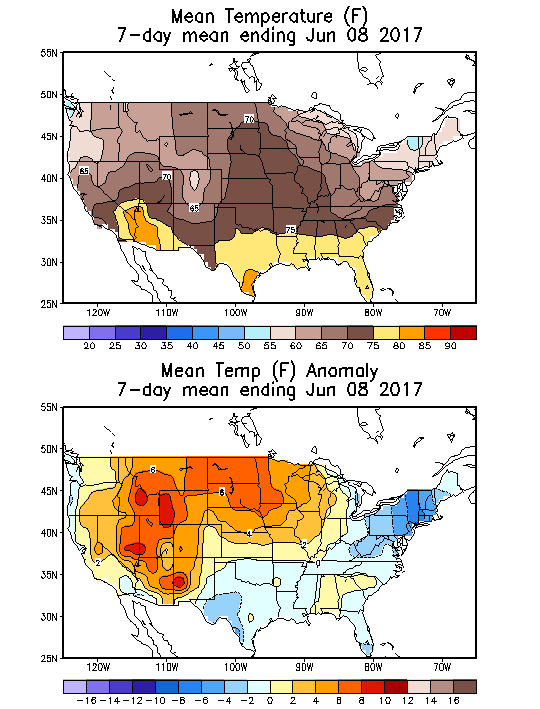
Source: NOAA National Weather Service
Deviation between average and normal (°F)
7-Day Mean ending Jun 08, 2017

Source: NOAA National Weather Service

